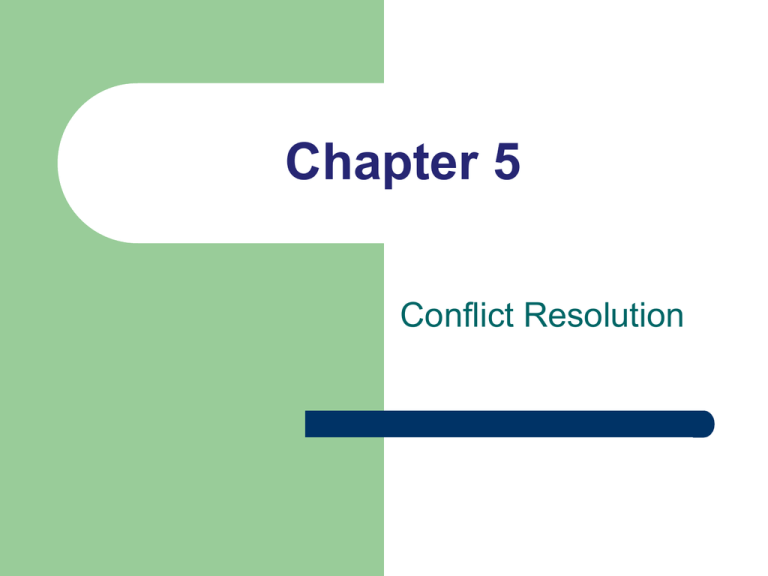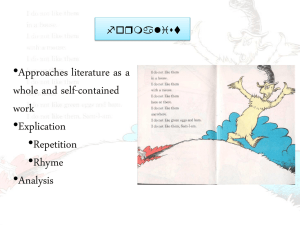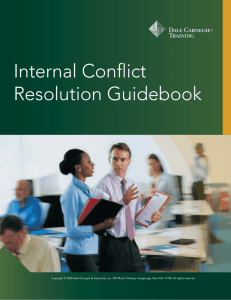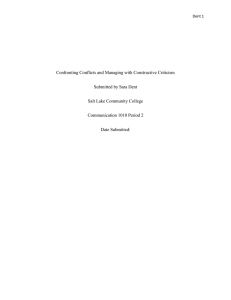MS-PowerPoint - Business Information Management
advertisement

Chapter 5 Conflict Resolution Conflict Important Conflict is the internal or external tension that occurs when you anticipate difficulty meeting important needs. Boss, spouse, child, etc. Conflict Types Five leading causes of conflict in the workplace: – Misunderstanding-miscommunication – Disrespect or disregard for other people – Conflicting egos – Impatience – Fear and insecurity over loss of control Conflict Types Pseudo conflicts (false conflicts) – Not real conflicts; they are perceived. – Two causes: faulty assumptions and false dilemmas – Faulty assumptions: mistaking assumptions for facts – False dilemmas: people only see two solutions to a problem Fact conflicts – Parties disagree about information that could easily be verified – Fact conflicts can turn into ego conflicts Conflict Types Ego conflicts – A dispute centers on status or power – Initial argument may be over a factual question – Conflict centers on “who” has the “right” facts Value conflicts – Focus on personal beliefs – Value rights, religion, etc. Need conflicts – Needs of one individual clash with the needs of another Conflict Management Styles Avoiders – See conflict as hopeless and useless – Are impersonal or distant – Remove self mentally or physically – Lack commitment to finding solutions (time, energy, confidence or skills) – Be an Avoider: to buy time, to defuse strong emotions, if the conflict isn’t worth it Conflict Management Styles Accommodators – Believe conflict is destructive – Overvalue maintaining relationships – Undervalue own needs – Don’t make waves – Want peace at any price – Be an Accommodator: when the issue isn’t that important to you or when conceding is easier Conflict Management Styles Forcers – – – – – – Believe winning is the only thing Love challenge and achievement Express anger when others don’t agree Are willing to sacrifice others who don’t agree Typically use emotional appeals, strong deliveries and persistence Be a Forcer: when decisions have to be made quickly, crisis Conflict Management Styles Compromisers – Believe half is better than none – Want each side to gain something – Use voting or bargaining to decide – Avoid the real issues – Typically use maneuvering, negotiating and trading – Be a Compromiser: disagreement isn’t vital Conflict Management Styles Collaborators – Believe both parties can meet their needs – See conflict as a natural way to meet needs – Want to hear the needs of others – View the other as equal in conflict – Be a Collaborator: when there is time, if both parties are willing to work together Conflict Strategy Guidelines Recognize the “enemies” that can limit your ability to manage conflict effectively. – Your desire to explain your side first – Failure to listen attentively – Fear of losing control, what you value – Misconception that one must win and the other must lose Conflict Strategy Guidelines Choose the right time. – Relaxed, free from distractions and prepared to spend time Take turns speaking and listening. – Listen open-mindedly rather than defensively – Paraphrase one another – Encourage active listening Conflict Strategy Guidelines Set the stage for finding a solution. – Work collaboratively – Brainstorm Identify your needs and those of the other person. – Keeps you focused on the issue – Identify the needs – Be empathic Four-Part Assertion Messages Plan what you want to say. – Four-Part Assertion Message Describe the behavior Identify your feelings State the tangible consequences Make a request Example: When you take personal calls on your cell phone while there are customers waiting in line (behaviour), I feel stressed (feeling), because I have to cover the service desk by myself (consequence). Would you please wait until your break to use your cell phone? (request). Be Assertive Assertive – Stating what you think, feel, want or need in a way that is direct, honest and respectful of others – Builds trust, helps prevent conflicts, gets needs met – Most conducive to a supportive style of communication Aggressive – Stating thoughts, feelings, wants or needs directly and honestly but disrespectfully – Can prevent conflict by fostering avoidance Be Assertive Non-Assertive – Respecting others while stating your thoughts, feelings, wants or needs indirectly or not at all – Avoid conflict, easy to please, cooperative team players – Can’t get needs met, may feel resentful Conflict Strategy Guidelines Express appreciation. – Thank the other person – End the discussion on a positive note Responding to Criticism Three types of criticism: – Manipulative – Vague – Valid Responding to Criticism Fogging – Use for manipulative criticism – Presents a non-defensive, indifferent response to criticism – Seeks to acknowledge the criticism – Does not agree or disagree Responding to Criticism Negative Assertion – Strongly agrees with valid criticism – Admits mistakes – Announces that the critic is right – Adds what you have learned from the mistake – Expresses a sad, regretful tone Responding to Criticism Negative Inquiry – Clarifies the intent of vague criticism – Shares a puzzled, confused tone – Seeks further information – Uses questions







